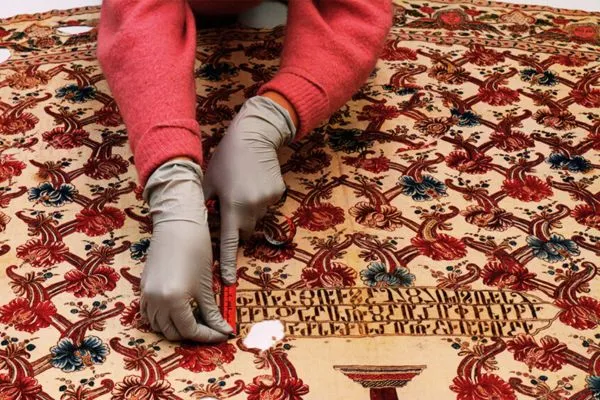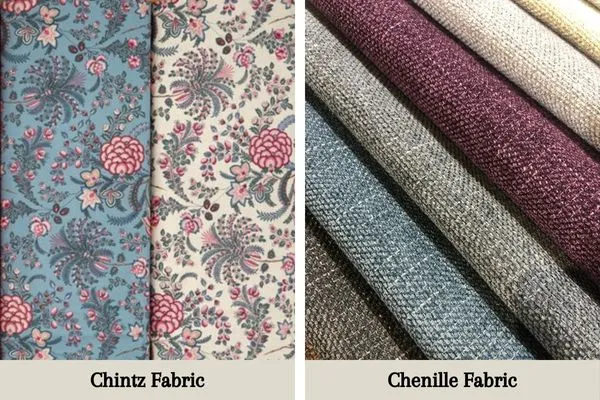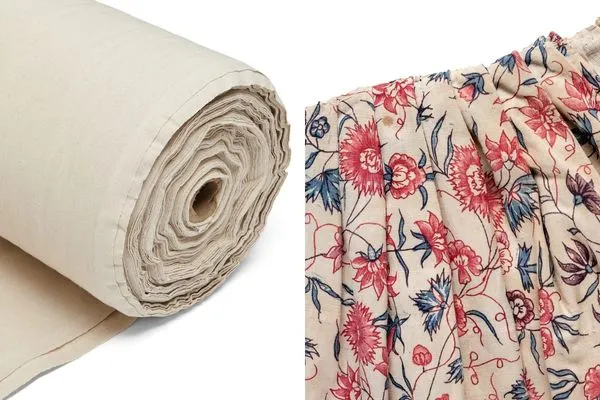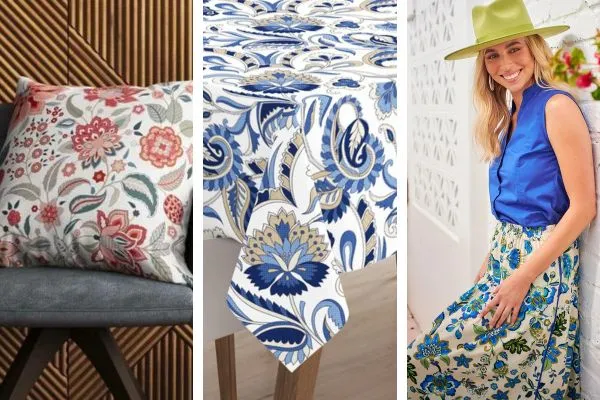Chintz isn’t just any old fabric; it’s a welcomed guest in the cotton world. Consider a cotton party in which chintz shines out with its style! As you can see, not all cotton fabrics are the same.

Chintz has its unique characteristics. The bright designs and sleek, glossy finish set it apart. Let’s get a deeper look at chintz and discover its mysteries!
Table of Contents
What is Chintz fabric?
Chintz refers to the plain cotton fabric with mild to heavyweight in nature. It is commonly used for drapes and decorative cushions applications. It is a printed cloth with large and multi-colored flowers. At certain times, the fabric is dyed in a solid color or printed technique with geometric designs.

Where is Chintz Made?
Chintz fabric originated in India when artists hand-painted or block-printed beautiful motifs on cotton. The term “chintz” is derived from the Hindi word “chint,” which reflects the multicolored attractiveness of the fabric. It gained popularity in 17th-century Europe after first becoming famous in India.

While traditionally created in India, modern chintz-style textiles are made all over the world using a variety of printing techniques. Modern variations mimic the glossy texture and bright designs of traditional Indian chintz, which is made in nations including India, England, and the United States.
What is the difference between Chintz and Chenille?
The difference between Chintz and Chenille is in the table below:
| Topic for the Difference | Chintz | Chenille |
| Definition | A cotton fabric glazed with a shiny finish. | A fabric made from soft, fuzzy-like textured yarn. |
| Features | It has a vibrant, colorful, and floral printed pattern. It has a glossy surface. | It does not feature any printed designs or distinctive appearance. It is well-known for its velvety, plush feel. |
| Applications | It is used for decorative purposes-upholstery, drapery, and ornamental items. | It is used for upholstery, bedding, and throws. |

What is the difference between Calico and Chintz?
Calico and Chintz are both cotton fabrics with distinct features. For instance:
Calico is a plain-woven and undecorated fabric. Features include
- It is lightweight, soft, plain weave, and versatile.
- It is used for clothing, crafting, and upholstery.
- Affordable and Durable.

Meanwhile, Chintz is printed and decorated fabric with vibrant, colorful designs and floral patterns. Features include:
- It has a glossy finish.
- Decorative use.
- Colorful and Elaborate Floral Matters.
Why was a Printed Cloth from India called Chintz?
From the term Chint to the vibrant and intricate design background, India is a constant connector to Chintz’s fabric. Indian Chintz fabrics were crafted through methods, for instance, hand-printing or block printing on cotton-based cloth. Even today, Chintz is popular for its printed cotton fabrics with intricate designs.

How to Identify Chintz Fabric?
Chintz fabric is mostly identified by its floral theme. Chintz is multi-colored and has repeated patterns. Patterns incorporate leaves, flowers, plants, gardens, and trees against a plain background. To identify themes, one can look into:
- Glossy, Shiny, or Polished Finish.
- Colorful and Intricate Floral Designs.
- Cotton-based material.
- Slightly stiff or crisp feel to the touch.
Manufacturing Process of Chintz Fabric
The traditional process of Chintz fabric used in India is time-consuming and complex. Vegetables were used in the production of Chintz fabric using different chemicals.
In modern days, the process of making Chintz fabric can be described in a few stages. For instance:
- Stage 01: Selection of Cotton Fiber
Selecting high-quality cotton fiber is suitable for weaving.
- Stage 02: Weaving
Then, those chosen cotton fabrics are spun into yarns. Then, it is woven into a plain, lightweight fabric using a loom.
- Stage 3: Giving Chintz a Distinctive Look
The fabric is then well-treated with a resin-like substance for a glaze or polished finish.
- Stage 4: Printing
Then, intricate designs are printed onto the cotton fabric using roller or screen printing. Dyes are applied here through rollers to create the desired patterns. Then, a fixing process goes through to set the colors.
- Stage 5: Washing and Finishing
The fabric is washed to remove any excessive dye or treatment residue. Additional finishing processes may enhance its texture, appearance, and the desired final product.
What is Chintz used for?
Since Chintz is a versatile fabric used for different purposes, features, and vibrant designs. Applications of Chintz fabric are as follows
- Upholstery: Chairs, Sofas, Cushions, and other furniture pieces.
- Home Decor: Pillows, Tablecloths, Bedspreads.
- Clothing: Dresses, Skirts, and Blouses.
- Crafts: Sewing, Quilting, and DIY

FAQ:
Why is it called Chintz?
The fabric ‘Chintz’ gets its term from the Hindi word ‘Chint.’ Chint means ‘Spotted’ or ‘Sprayed.’ The fabric also became popular in Europe when it started to be imported from India. At that time, only printed cotton fabrics were treated in a particular manner.
What is Chintz glazed with?
Chintz fabric was glazed with distinct substances to give a glossy finish and increase its durability. A mixture of starch, wax, and resin was mainly used to achieve the glazed effect in Chintz.
The glazing process requires applying the mixture to the fabric and polishing it to create a surface of shine.
What is Modern Chintz?
Modern Chintz refers to the vibrant, floral printed patterns on a cotton or cotton-blend base. This modern type of Chintz hardly has any heavy glazing suitable to the traditional chintz.
Is Chintz cotton?
Chintz is a cotton or cotton-blend-made product with a given glaze. The base material is Chintz because adding cotton helps the fabric hold the vibrant dye and intricate pattern.
Is Chintz in style?
Chintz makes an occasional comeback in a variety of forms. Its patterns and fabrics experience huge popularity in retro and vintage styles.
Besides, Chintz is in the style of a grand millennial that contributes to decorating trendy and modern designs.
What language is Chintz?
Chintz, the word, is derived from the Hindi word ‘Chint,’ which means spotted, variegated, etc.
When was Chintz popular?
Chintz was at the peak of popularity in the 1940s. By the year 1680, Chintaz had become massively popular. Fast forward to the 1900s, Chintz faced constant fluctuations.
Why is Chintz called a Muslin Cloth?
Chintz is called a Muslin cloth because of the similarities in the material used. Chintz is cotton fabric. Muslin cloth is also a plain-woven cotton fabric. Both fabrics come in different grades, densities, and breathable nature.
Also, both Chintz and Muslin cloth are used in the decorative qualities for their intricate designs. Hence, Chintz is sometimes synonymous with Muslin Cloth.
What is Chintzs’ design?
Chintz’s design is characterized by colorful floral patterns printed on cotton fabric. Mostly, designs feature a variety of flowers, leaves, and other elements.
What type of material is Chintz?
Chintz is a cotton-type fabric that is glazed with a shiny finish. The only type of material used in Chintz is Cotton.
What pattern goes with Chintz?
Chintz plays well with patterns. It is recommended for Chintz to pair floral-type designs with geometric patterns, for instance, striped, gingham, and plaid.
What is the weight of the Chintz fabric?
The weight of the Chintz fabric is medium. Chintz, being a medium-weight plain weave fabric, is made from cotton. It is given a polished finish for applying large designs and home products.
Conclusion
To conclude, it can be said that Chintz is distinguished by its polished and glazed finish. It has vibrant printed designs. Because of this vibrant pattern, it is produced in India.
Although it is produced in India, it has become a popular European fabric. So far, Chintz fabric has come a long way for its decorative qualities. Let us know how you have used Chintz in your daily life!
